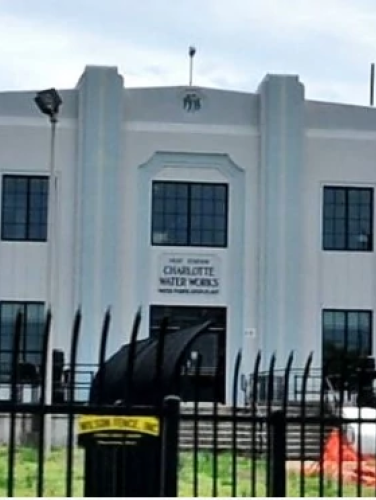
Charlotte Water Works/Vest Station
(ca. 1924)
Considered state of the art when completed in 1924, the Art Deco Moderne styled Vest Station water treatment plant still contributes significantly to Charlotte’s overall water system.
900 and 1024 Beatties Ford Road, Charlotte, NC 28216
The summer of 1911 was not good for Charlotte. It was the worst drought the city had seen in 50 years. The city's only water supply – Big Sugaw Creek, now known as Irwin Creek – was drying up. The city’s reservoir dried completely by July. Conditions were so bleak that city officials had to ship water in by train from the Catawba River and surrounding cities. What little water that was available remained cut off except at intervals when needed to flush out the sewers. Factories and shops were forced to close. Police officers went door-to-door removing water sprinkling systems from residents’ yards. Bathing became a rare luxury.
Property Quick Links
The problem could have been avoided. Starting in 1904, C. H. Campbell (superintendent of the city’s water works) recognized that Charlotte lacked the water capacity to support its growing population. He began petitioning the city’s Board of Alderman to fund connection of the city’s water system to Catawba River, but the aldermen were hesitant to spend the money. By 1911, everyone realized the mistake. City officials working to attract new businesses to Charlotte were embarrassed by the poor planning, and newspapers around the country lampooned the city government’s short-sightedness. The remedy required a bond issuance of some $815,000 (more than $26 million in present value), which Charlotte residents quickly approved. By April 1912, with the installation of a new piping and pumping system from the Catawba River, the first stage of a two-step process was complete, resolving the immediate water supply problem, if only temporarily. The second stage – the lifeline needed to help Charlotte become the South’s most progressive industrial city – required the Vest Water Treatment Plant.
By 1918, Charlotte was North Carolina’s biggest city, with a population of 50,000. It became clear that a sophisticated water purification plant was necessary to support urban growth. The city’s existing filtration plant (opened in 1905) was antiquated and too far away from the Catawba to provide an adequate water supply. When completed in 1924, the Vest Station was the largest & best-equipped water treatment and storage facility in North Carolina, with filters that could treat 8.3 million gallons per day and a storage capacity for 3 million gallons of clean water. As Charlotte continued to grow, so too did its need for readily available clean water and, therefore, the need to increase Vest Station’s operational capacity. A series of upgrades, expansions, and new technological advances between 1936 and 1949 increased the facility’s daily treatment capacity to nearly 25 million gallons of water, with clean water storage facilities for nearly 12 million gallons. Also in 1949, Charlotte became the first southeastern U.S. city to introduce fluoridation into its water system, adding what the National Institute of Dental Research called the "single greatest advancement in dental health history." Charlotte’s water needs have long since surpassed the capacity of Vest Station, but even with the addition of more modern treatment facilities, Vest Station remains a valuable asset in the city’s overall water system due to the high efficiency and economical operation still realized by its now century-old state-of-the-art technology.

